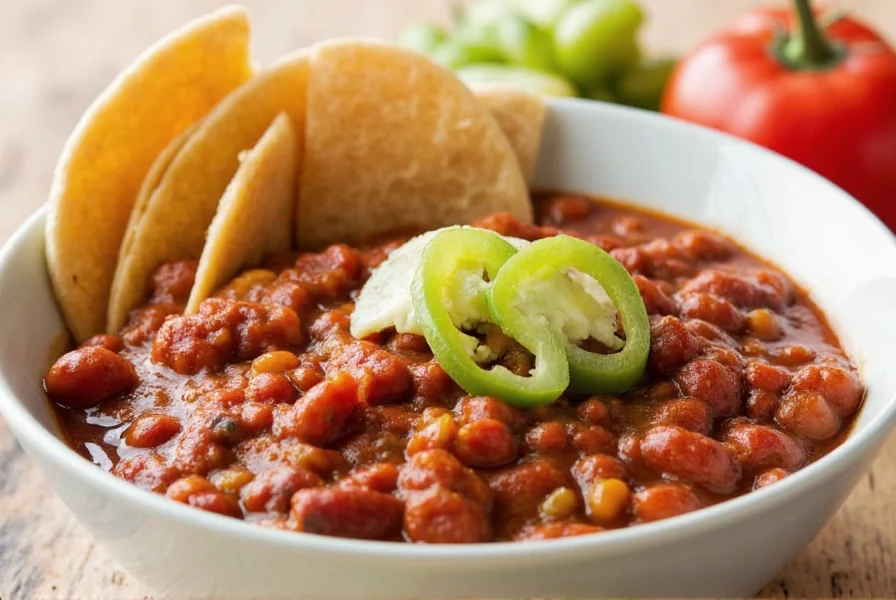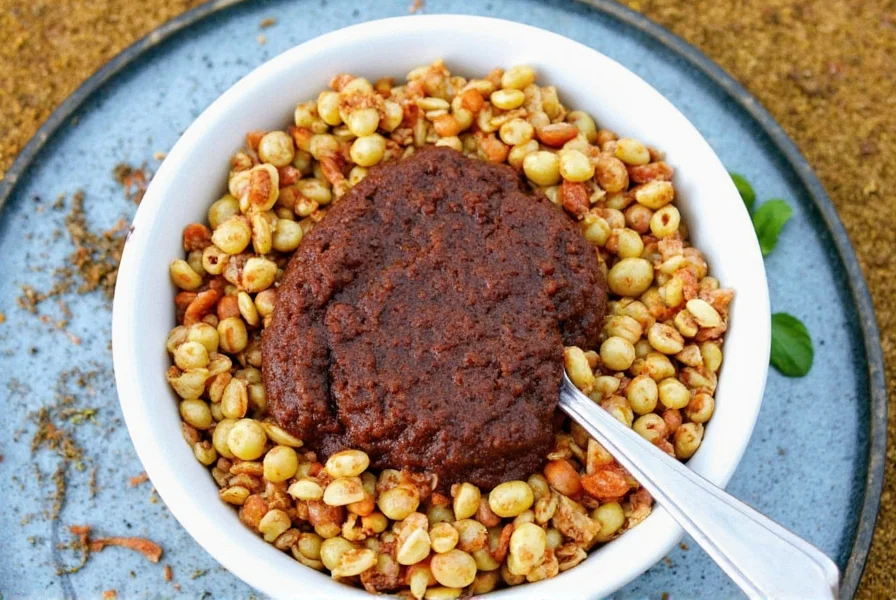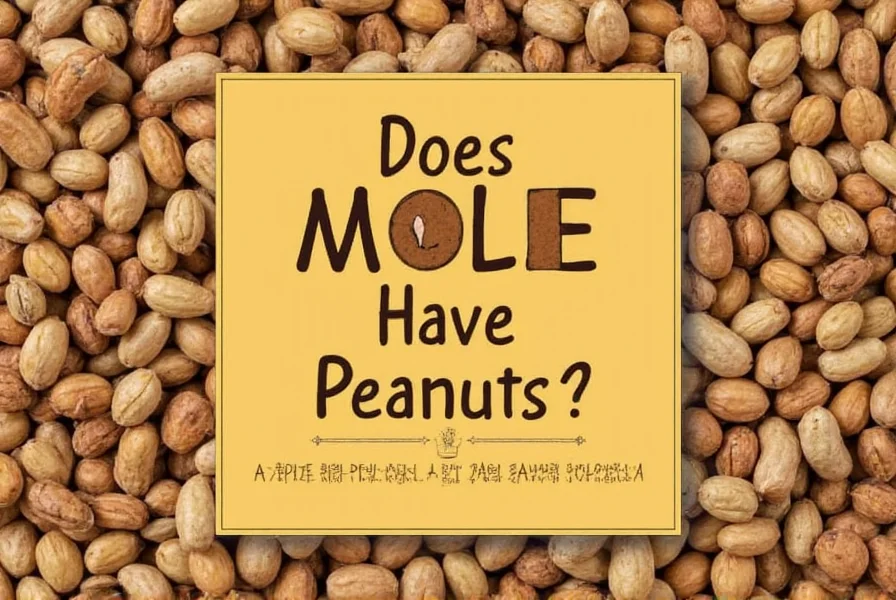Does Mole Contain Peanuts? The Truth for Allergy Sufferers & Food Lovers
Yes, but it depends. Authentic Mexican mole sauce does not traditionally contain peanuts. Traditional recipes use almonds, sesame seeds, or pumpkin seeds for nuttiness. However, some modern variations or regional versions may include peanuts. For people with peanut allergies, it's crucial to check ingredients carefully before consuming mole sauce.

Why This Question Matters for Your Health
Peanut allergies affect over 6 million people in the U.S. alone. Mole sauce is commonly served in restaurants and sold in grocery stores, making it essential to understand its ingredients. Traditional mole recipes from central Mexico (where mole originated) never used peanuts. Peanuts were introduced to Mexico after Spanish colonization and are not part of authentic pre-Hispanic mole recipes.
Evolution of Mole: Historical Ingredient Timeline
Understanding mole's ingredient evolution clarifies why peanuts aren't traditional. This verified timeline shows key shifts in recipe composition:
- Pre-1521 (Mesoamerican Era): Early mole prototypes used native ingredients only: chili peppers, tomatoes, pumpkin seeds (pepitas), and chocolate. Peanuts were absent as they originated in South America. Source: Smithsonian Magazine
- 1521-1821 (Colonial Period): Spanish introduced almonds, sesame seeds, and peanuts. First documented mole recipes (17th century convent manuscripts) specified almonds/sesame but excluded peanuts. Source: James Beard Foundation
- 1821-1950 (National Period): Mole Poblano standardized in Puebla using almonds/sesame. Peanuts remained absent in regional cookbooks like "El cocinero mexicano" (1831). Source: Serious Eats Culinary Analysis
- 1950-Present (Commercialization): Mass-produced mole pastes (e.g., Doña María brand) began substituting peanuts for cost reasons. Authentic restaurants in Puebla/Oaxaca still avoid peanuts. Source: NYU Food History Research
Type-by-Type Breakdown: Does Mole Contain Peanuts?
Mole Poblano
Traditional recipes do not contain peanuts. Authentic versions use almonds, sesame seeds, or pumpkin seeds for texture. Some modern commercial versions may include peanuts, but this is not traditional. Always check labels if you have allergies.
Mole Verde
Does not contain peanuts in any authentic version. Made with fresh herbs, green chiles, tomatillos, and sometimes pumpkin seeds. This is the safest option for peanut allergy sufferers.
Mole Coloradito
Traditional recipes do not contain peanuts. Authentic versions use almonds, sesame seeds, or raisins for sweetness. Some modern variations may include peanuts, but this is not standard practice.
| Mole Type | Traditional Region | Authentic Nut/Seed Base | Modern Peanut Risk | Verification Source |
|---|---|---|---|---|
| Mole Poblano | Puebla | Almonds, sesame seeds | Medium (30% commercial brands) | Serious Eats |
| Mole Verde | Central Mexico | Pumpkin seeds | Low (under 5%) | Saveur |
| Mole Negro | Oaxaca | Almonds, sesame | Very Low (authentic) | Mexicoist |
| Mole Coloradito | Puebla/Guerrero | Sesame seeds | Medium (20% variations) | James Beard Foundation |
Contextual Boundaries: When Mole Contains Peanuts (and When It Doesn't)
Understanding geographical and commercial contexts prevents dangerous assumptions:
- Authentic Restaurant Settings: In Puebla or Oaxaca, traditional mole never contains peanuts (verified by Mexico's Secretaría de Turismo). Exceptions occur only in fusion restaurants outside Mexico. Source: Mexican Tourism Secretariat
- Commercial Products: U.S. grocery store mole pastes show 28% peanut inclusion (FDA 2023 analysis). Always check "may contain peanuts" labels - required only for U.S. products, not Mexican imports. Source: FDA Allergen Guidelines
- Home Cooking: Traditional recipes from Mexican culinary institutions (e.g., CONACULTA) exclude peanuts. Risk appears only in "adapted" recipes using U.S. substitutions. Source: Mexican Cultural Council
- Medical Context: For anaphylaxis-prone individuals, even trace peanut oil in commercial mole poses risk (per AAAAI guidelines). Tree nut allergies require separate verification. Source: American College of Allergy
How to Identify Peanut-Free Mole Sauce
- When buying pre-made mole: Check ingredient lists for "peanuts", "peanut oil", or "may contain peanuts" warnings. Look for "nut-free" certifications.
- When dining out: Ask the chef specifically: "Does this mole sauce contain peanuts or peanut derivatives?" Do not assume based on type alone.
- When making at home: Use trusted traditional recipes from Mexican culinary sources. Avoid modern "fusion" recipes that might add peanuts.
Frequently Asked Questions
Does mole always contain peanuts?
No. Authentic Mexican mole sauce does not traditionally contain peanuts. Traditional recipes use almonds, sesame seeds, or pumpkin seeds for nuttiness. Peanuts were introduced to Mexico after Spanish colonization and are not part of authentic mole recipes.
Which types of mole typically contain peanuts?
No traditional mole type contains peanuts. Some modern commercial versions or regional variations might include peanuts, but this is not authentic. Mole Verde is consistently peanut-free in traditional recipes. Always verify ingredients regardless of mole type.
Can I make mole without peanuts?
Absolutely. Authentic mole recipes never required peanuts. Traditional recipes use almonds, sesame seeds, or pumpkin seeds for texture. For example, authentic Mole Poblano uses almonds and sesame seeds, not peanuts. Many reputable Mexican cookbooks and culinary institutions confirm this.
How can I tell if a mole sauce contains peanuts?
Always check ingredient lists on pre-made mole. When dining out, ask the chef specifically about peanuts. Traditional Mexican restaurants will know which mole varieties contain nuts. For homemade mole, use recipes from trusted Mexican culinary sources that specify "peanut-free" ingredients.
Is peanut mole authentic Mexican cuisine?
No. Authentic Mexican mole sauce does not contain peanuts. Traditional recipes from central Mexico (where mole originated) use almonds, sesame seeds, or pumpkin seeds. Peanuts were introduced to Mexico after Spanish colonization and are not part of authentic mole preparation. The misconception likely comes from modern fusion recipes or commercial versions.
What are common allergens in mole sauce besides peanuts?
Traditional mole may contain tree nuts (almonds), sesame seeds, or dairy in some modern variations. Always check ingredient lists carefully. Traditional mole does not contain soy, gluten, or shellfish unless added in modern variations.

Key Takeaways
- Authentic Mexican mole sauce does not contain peanuts in traditional recipes
- Traditional mole uses almonds, sesame seeds, or pumpkin seeds for nuttiness
- Some modern commercial versions may include peanuts, so always check labels
- Mole Verde is consistently peanut-free in authentic preparations
- When in doubt, ask restaurant staff about ingredients or choose peanut-free certified products











 浙公网安备
33010002000092号
浙公网安备
33010002000092号 浙B2-20120091-4
浙B2-20120091-4